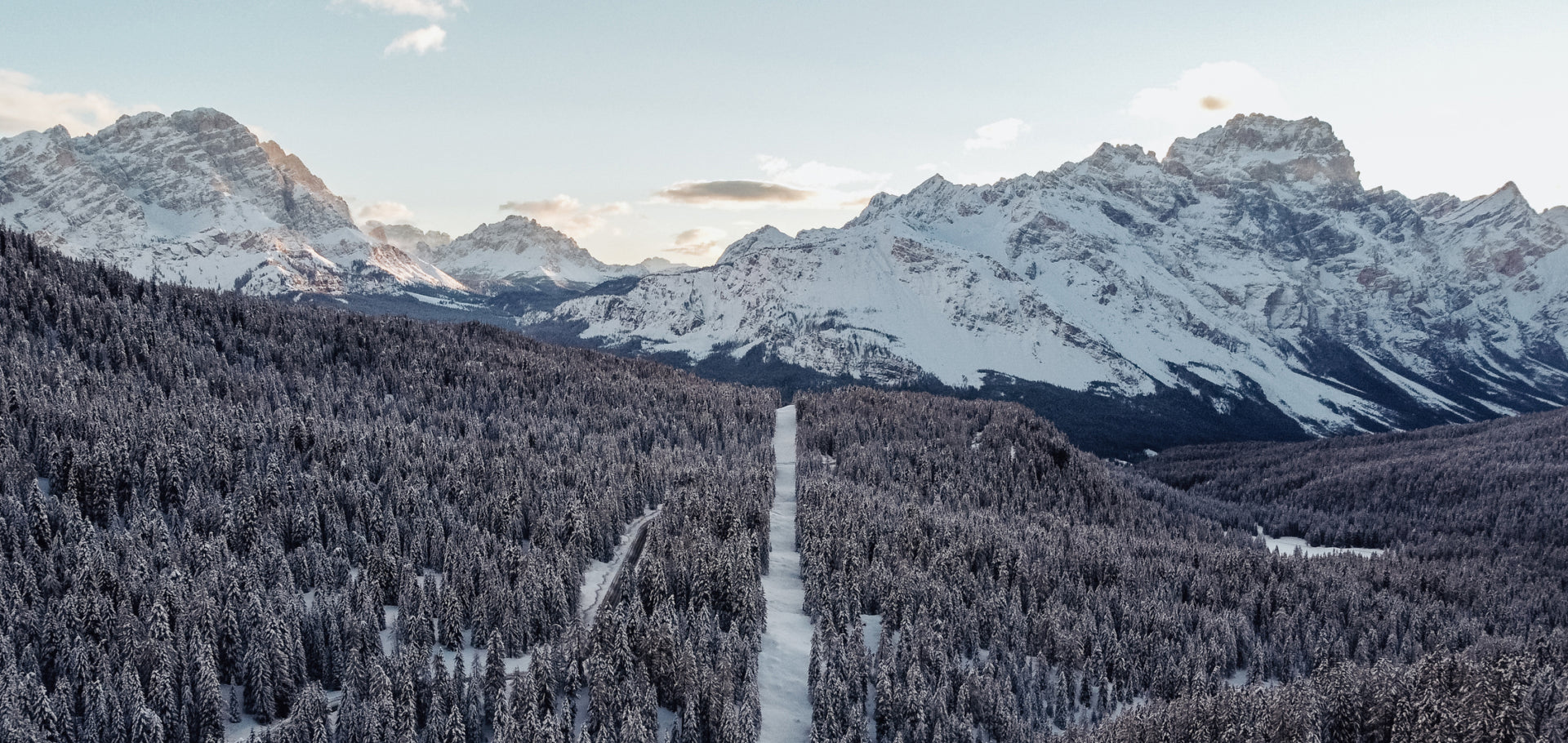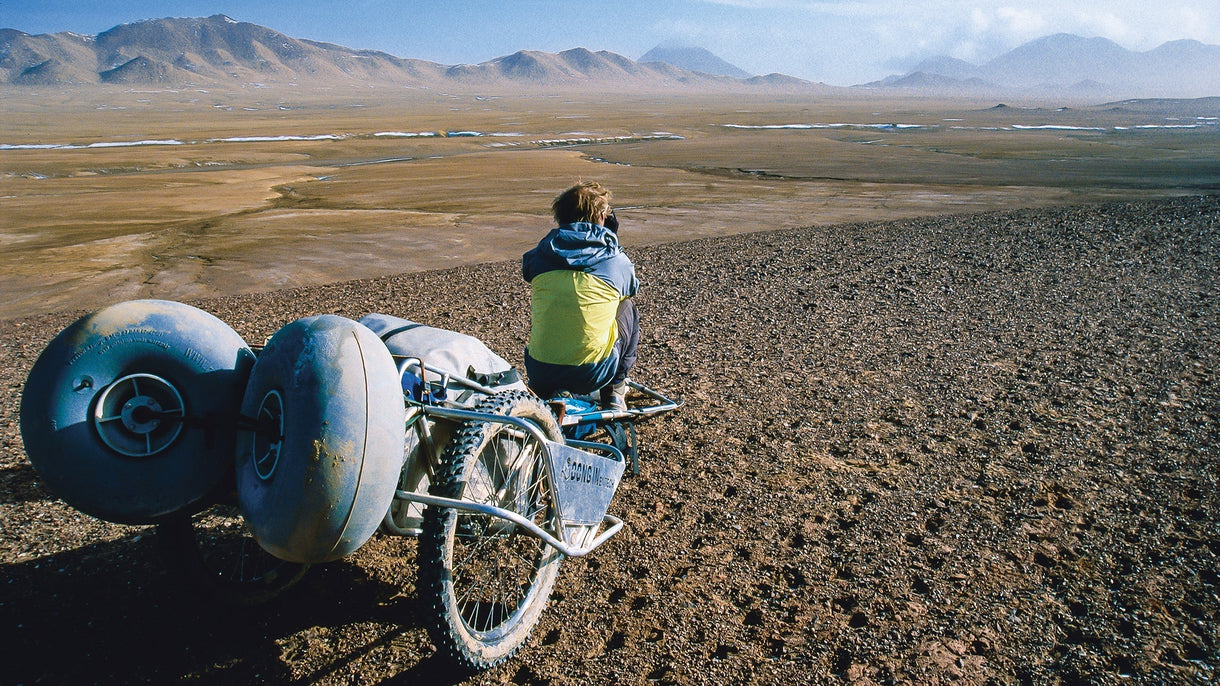All photos by Matteo Pavana
Lines are everywhere. They trace geography and humanity, defining both boundaries and connections.
A fundamental symbol for the ski and snowboard community, these lines trace our aspirations and sketch our dreams. The process of planning, reaching and riding a line can consume those who love winter.
Yet, lines can also be lost forever—to development, to climate change, to nature—and we often don’t recognise a loss until it’s too late.
During the first months of 2021, I went on a road trip through the Italian Alps, Dolomites and Apennines with photographer Matteo Pavana to trace threatened lines. We left with fleeting tracks in the snow and a lasting confirmation that we need to incite change before more lines are gone forever.
 The high-alpine landscapes of the Alps are at risk from climate change and ski-area expansion. Resistance takes many shapes. One way is simply skiing and enjoying these last wild places. The author and friends make their way down from Marmolada, the highest mountain in the Italian Dolomites.
The high-alpine landscapes of the Alps are at risk from climate change and ski-area expansion. Resistance takes many shapes. One way is simply skiing and enjoying these last wild places. The author and friends make their way down from Marmolada, the highest mountain in the Italian Dolomites.
The End: Resistance on the Marmolada
I am crouching in a corner of the Pian dei Fiacconi mountain hut in the Trentino region—or at least in a corner of what’s left of it—hiding from the cold. The trip is starting with what could be an ending. For years, this hut, along with its owner Guido Trevisan, was a symbol of resistance against those who wanted to build a cable car on this broad, open face of the Marmolada, home to some of the best ski touring terrain in Italy.
Guido picks his way through the debris. His worn hands show years of dedication to a slower mountain life. He ran the hut as a meeting point, a place of welcome and exchange. Even when the basket lift leading up to the hut was decommissioned, Guido opposed rebuilding it, despite the economic repercussions. Then, at the start of last winter, an avalanche destroyed the hut, leaving very little behind.
 “Chaos was the law of nature; order was the dream of man.” –Henry Adams. The Pian dei Fiacconi hut after a nighttime avalanche on the Marmolada Glacier in December 2020. Trentino-Alto Adige, Italy.
“Chaos was the law of nature; order was the dream of man.” –Henry Adams. The Pian dei Fiacconi hut after a nighttime avalanche on the Marmolada Glacier in December 2020. Trentino-Alto Adige, Italy.
Guido moves a few beams and picks up an old photo, which was once pinned to the wall. It depicts the area’s first chairlift. He describes how just days after the avalanche the new investors surveyed the site by helicopter to demonstrate that, right in the slide path, it was completely safe to build new cableways, for which they had recently bought permits.
 Guido Trevisan, owner of the Pian dei Fiacconi hut. Guido is fighting to keep ski lifts off Europe’s last living glaciers, like the Marmolada, despite the economic repercussions for himself as a hut owner.
Guido Trevisan, owner of the Pian dei Fiacconi hut. Guido is fighting to keep ski lifts off Europe’s last living glaciers, like the Marmolada, despite the economic repercussions for himself as a hut owner.
We leave the dark skeleton that Guido once called home, and I wait for my eyes to adjust to the bright sunlight reflecting off the snow. I turn to look up at the lines that we traced during a perfect day of powder with friends. I try to imagine cable cars swooping over the glaciers and new man-made ski slopes slicing down.
Guido shuts the door of the hut behind him, looks at me and smiles. He has no intention of calling this an ending.
 Objective hazards: Climate change and this dangerous zone below Monte Serodoli in the Adamello Brenta Nature Park. Luca Albrisi tries to navigate both.
Objective hazards: Climate change and this dangerous zone below Monte Serodoli in the Adamello Brenta Nature Park. Luca Albrisi tries to navigate both.
Outdoor Rights: Awareness and action in Serodoli
The day is extremely hot for mid-February, punctuated by the distant rumbles of sun-exposed slopes shedding their snow. I look at Madonna di Campiglio and the Brenta Dolomites on the other side of the valley and think back to when I worked there teaching snowboarding. I would escape into the woods to look for a little fresh snow whenever I had a free moment.
A few years later, after moving to another valley, I returned to Campiglio in search of one of my favorite snowboard lines. Instead of those cliffs and corridors between the trees that I knew by heart, I found a ski run—wide, steep, well-trodden and cut straight through the woods.
Now, I’m across the valley near Serodoli, one of the few spots here that is still completely untouched by lifts. The uncontaminated beauty of this place forms part of the Adamello Brenta Nature Park, which attracts an abundance of backcountry travelers in both winter and summer.
Ongoing plans to build lifts have, for now, been thwarted by several local activist groups and associations, including the one I helped found: The Outdoor Manifesto. While I descend from the summit of Monte Serodoli to the lake below, I feel how much work each of us must do to ensure another lift doesn’t spoil this last piece of untouched wilderness.
 Luca Albrisi experiences the magic of beech trees near Fanano, Italy, on what was described by locals as one of the coldest days in the last 30 years. Recently, the beech trees haven’t had their snow blankets until late February.
Luca Albrisi experiences the magic of beech trees near Fanano, Italy, on what was described by locals as one of the coldest days in the last 30 years. Recently, the beech trees haven’t had their snow blankets until late February.
Melted in Frost: Ephemeral lines in the Modena Apennines
In a bar in Fanano, people are talking about how bitterly cold this winter has been. We have traveled south to document the radical impact that warming temperatures are having on the Apennines. And yet, here we are during a winter that Lello, a splitboarding friend who lives in the area, describes as one of the coldest of the last 30 years. Even though this is good news in the short term, it doesn’t reflect the long-term trends.
Globally, eight of the 10 hottest years since 1961 have been recorded in the last decade, with temperatures between 1.26–1.71 degrees Celsius warmer than average. In Fanano, during the coldest months, the temperatures average between 2 to 7 degrees Celsius, and the possibility of snowfall is increasingly rare. “In the last 10 years, we have seen many winters where it was possible for us to ride only on artificial snow and sometimes not even on that,” says Lello. “Not to mention that the snow comes later and later. In some winters, we had to wait until the end of February to use our splitboards.”
We decide to make the most of the current conditions by rediscovering lines that are now rarely rideable and set out into a dense fog, which merges with fresh snow on the ground. We cross streams, skinning high and low among beautiful, snow-laden beech trees, pausing to listen to them sway in the wind above these ephemeral lines.
The next morning, we rise with the sun to skin over to Libro Aperto, a higher massif beyond which numerous new cableways are planned to create one of the largest ski areas in Italy. These peaks are often lashed by biting winds, and today is no different. Above the beech forest, we find a thick layer of crust. I look up toward the peak and wonder how they can justify such huge investments—largely from public funds—when we might not be able to enjoy these lines for much longer.
 Above his hometown in Celentino, Val di Peio, Italy, the author stops to observe traces of the other visitors to the area, knowing that disturbing them and their winter energy reserves can be fatal.
Above his hometown in Celentino, Val di Peio, Italy, the author stops to observe traces of the other visitors to the area, knowing that disturbing them and their winter energy reserves can be fatal.
The Beginning: Respecting animal tracks in Stelvio National Park
We crouch to look at tracks in the snow in the woods behind my home: Stelvio National Park’s Val di Peio. The hoofprints belong to a chamois, a species of goat-antelope. With me is Gabriele Canella, a mountain leader and park guide with deep knowledge of the region. Our outings and lines across the powder often inspire debates about humanity’s relationship with nature, sustainability and land management. Today’s discussion started off with these tracks, many of which can be found on the first part of our route.
Although we may think the skiing and snowboarding lines we trace in the wilderness have no impact, as Gabri explains, that is not always the case. It was a cold winter with heavy snowfall, which makes it harder for animals to find food. Additionally, they must consume more energy as they move through deep snowdrifts. Our presence as we ascend or descend may cause animals to flee, often with fatal consequences.
We stand up, knowing we will go no further. Sometimes leaving no tracks at all can be the start of a new line.























































